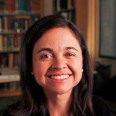An ecologist from Stony Brook University, a theoretical physicist from University of Colorado Boulder and a chemical biologist from Harvard University

NEW YORK, June 26, 2019 – Three female scientists have been named Laureates of the Blavatnik National Awards for Young Scientists, each receiving $250,000, the largest unrestricted scientific prize offered to America’s most-promising, faculty-level scientific researchers. It marks the first time in the program’s 13-year history that all of the recipients are women.
The Blavatnik Family Foundation and the New York Academy of Sciences announced the 2019 national laureates, honored for their work in the awards’ three disciplines — Life Sciences, Physical Sciences & Engineering and Chemistry. Nominated by 169 research institutions from across 44 states, the Blavatnik National Awards received 343 nominees – the largest pool of nominees ever received by the program for those 42 years of age and younger.
“These three women are leading scientists and inventive trailblazers with stellar accomplishments in their respective fields,” said Len Blavatnik, founder and chairman of Access Industries, head of the Blavatnik Family Foundation and member of the President’s Council of the New York Academy of Sciences.
“Their groundbreaking research leads the way for future discoveries that will improve the world and benefit humankind. It’s exciting to see these three brilliant scientists chosen as the 2019 Blavatnik National Laureates,” Blavatnik said.
The recipients were selected from 31 finalists.
The 2019 Blavatnik National Laureates are:
Life Sciences: Heather J. Lynch, Stony Brook University, for her unique synthesis of cutting-edge statistics, mathematical models, satellite remote sensing and Antarctic field biology to understand the spatial and temporal patterns of penguin colonies to predict population growth, collapse and possible extinction in the face of climate change.
Physical Sciences & Engineering: Ana Maria Rey, University of Colorado Boulder, for her pioneering contributions to the field of theoretical atomic, molecular and optical physics, including her paradigm-shifting theories on atomic collisions, which led to the development of the world’s most accurate atomic clock.
Chemistry: Emily Balskus, Harvard University, for her transformative work identifying the novel chemistry of the gut microbiome and deciphering its role in human health and disease.
The 2019 Blavatnik National Laureates and Finalists will be honored at the Blavatnik National Awards ceremony on Monday, Sept. 23, at the American Museum of Natural History in New York.
“Our academy has always supported diversity in STEM, so we are incredibly proud to see these three scientists named as 2019 Blavatnik National Laureates,” said Ellis Rubinstein, president and CEO of the academy and chairman of the awards’ Scientific Advisory Council. “It is also the first time a Hispanic immigrant [from Colombia] will be honored as a national laureate - a wonderful role model for Latina girls considering a STEM career. In addition, with the increasing threat of climate change, the academy, in collaboration with the United Nations and its Sustainable Development Goals, aims to address the grand challenges of the planet, so we are encouraged to see an expert Antarctic ecologist join the growing global community of Blavatnik Awards scholars that together can help us find sustainable solutions for our planet.”
About the Blavatnik Awards for Young Scientists
The Blavatnik Awards for Young Scientists, established by the Blavatnik Family Foundation in the United States in 2007 and administered by the New York Academy of Sciences, began by identifying outstanding regional scientific talent in New York, New Jersey and Connecticut. The Blavatnik National Awards were launched in 2014 and, in 2017, the awards were expanded to young scientists in the United Kingdom and Israel. By the close of 2019, the Blavatnik Awards will have awarded prizes totaling over $8.4 million and will have recognized 284 young scientists and engineers from 45 countries, working in 35 scientific and engineering disciplines.
About the Blavatnik Family Foundation
The Blavatnik Family Foundation is an active supporter of world-renowned educational, scientific, cultural, and charitable institutions in the United States, the United Kingdom, Israel, and throughout the world. The Foundation is headed by Len Blavatnik, a global industrialist and philanthropist and the founder and chairman of Access Industries, a privately held U.S. industrial group with global strategic interests in natural resources and chemicals, media and telecommunications, real estate, and venture capital. See more at www.blavatnikfoundation.org.
About The New York Academy of Sciences
The New York Academy of Sciences is an independent, not-for-profit organization that since 1817 has been committed to advancing science, technology, and society worldwide. With more than 20,000 Members in 100 countries around the world, the academy is creating a global community of science for the benefit of humanity. The academy's core mission is to advance scientific knowledge, positively impact the major global challenges of society with science-based solutions, and increase the number of scientifically informed individuals in society at large. Please visit us online at www.nyas.org and follow us on Twitter at @NYASciences.
To follow the progress of the Blavatnik Awards, please visit www.blavatnikawards.org or follow us on Facebook and Twitter (@BlavatnikAwards).
Media contact
Kamala Murthy
Kmurthy@nyas.org
212-298-3740
About the 2019 National Laureates
 Heather J. Lynch, PhD
Heather J. Lynch, PhD
2019 Blavatnik National Laureate in Life Sciences
Associate Professor of Ecology and Evolution
Institute for Advanced Computational Science, Stony Brook University
Biography
Assistant Research Scientist, University of Maryland
Postdoctoral Research Associate, University of Maryland
PhD, Harvard University
MA, Harvard University
AB, Princeton University
Unique synthesis of cutting-edge statistics, mathematical models, satellite remote sensing, and Antarctic field biology to understand the spatial and temporal patterns of penguin colonies to predict population growth, collapse, and possible extinction.
Dr. Heather J. Lynch is an ecologist who studies the temporal and spatial organization of Antarctic penguin colonies, with a particular interest in understanding where penguins breed, how populations might be changing, and how we can use new technologies to monitor them more efficiently. Dr. Lynch’s interest spans all spatial scales, from understanding the detailed three-dimensional structure of penguin colonies, to continental-scale surveys using satellite imagery. “As someone who loves all areas of science and math equally, it’s been difficult to ‘settle down’ into a research career that fits neatly into any one discipline. But I’ve come to appreciate that there are some beautiful stories to be told in the no-man’s land between different research areas and that basic science and applied science can work hand-in-hand,” said Dr. Lynch.
Through her use of satellite imagery, Dr. Lynch discovered several previously unknown colonies of Adélie penguins—1.5 million penguins in all—in an archipelago known as the Danger Islands. Her work is at the forefront of using computer vision to automate satellite imagery interpretation for tracking Antarctic wildlife. By combining population data from satellite imagery, decades of data collected from remote site visits of Antarctic breeding grounds, and sophisticated statistical models tailored for integrating patchy data, Dr. Lynch and her collaborators have uncovered fluctuations in population abundance stretching back to the late 1970s. In concert with detailed simulations of how penguin colonies form and collapse, these models can predict whether a penguin colony is likely to undergo population collapse. Beyond her groundbreaking advances in understanding ecological spatial dynamics, Dr. Lynch is a regular advisor to Antarctic policymakers, has developed decision support software to aid in the design of Marine Protected Areas, and works closely with the Antarctic tourism industry to identify environmentally sensitive sites. At the crossroads of basic and applied research, Dr. Lynch is perfectly positioned to translate population forecasting into improved decision-making and management in Antarctica as her research related to Antarctic penguin populations addresses important ecological questions and provides key information on the health of the Southern Ocean ecosystem and the direct impact of climate change.
“Heather Lynch is a brilliant, multitalented scientist. She has developed novel approaches to using remotely sensed information to document, down to the sub-meter scale, the dynamics of penguin colonies. Simultaneously, she has carried out field studies to create models capturing how these animals interact with each other and their vulnerability to their predators. Combined together within a metapopulation framework, she is giving us an unprecedented view into a critically threatened ecological system in one of the remotest places on Earth. There is nothing about any aspect of her research that is straightforward and yet she has succeeded in ways that will enable others to follow in her footsteps, making us better able to understand and respond to climate change and other global threats.” —Professor David K. Skelly, Frank R. Oastler Professor of Ecology at Yale University, Yale School of Forestry & Environmental Studies, and Director of The Yale Peabody Museum of Natural History; Member of the 2019 Blavatnik National Awards Jury
 Ana Maria Rey, PhD
Ana Maria Rey, PhD
2019 Blavatnik National Laureate in Physical Sciences & Engineering
JILA Fellow & Professor of Physics
University of Colorado Boulder
Biography
Postdoctoral Fellow, ITAMP-Harvard Smithsonian CFA
Postdoctoral Researcher, National Institute of Standards & Technology
PhD, Department of Physics, University of Maryland College Park
BS, Departamento de Física, Universidad de los Andes, Colombia
Pioneering contributions made to the field of theoretical atomic, molecular, and optical physics, including her paradigm-shifting theories on atomic collisions, which led to the development of the world’s most accurate atomic clock, a generational technological advancement in the field.
Prof. Ana Maria Rey is a leading theoretical scientist in the field of atomic, molecular, and optical physics, who is most well-known for developing a fundamentally new understanding of atomic collisions with direct applications to timekeeping and quantum simulation. Her theory provided a paradigm shift in the precise measurements of time that led directly to the development of the world’s most accurate atomic clocks. Since joining the faculty in the Physics Department and JILA (formerly Joint Institute for Laboratory Astrophysics) at the University of Colorado Boulder in 2008, Prof. Rey has looked to take advantage of the unique properties displayed by alkaline earth elements, such as strontium. By understanding atomic interactions between ultracold strontium atoms, Prof. Rey and colleagues were able to improve the accuracy of atomic clocks by more than a thousand-fold over the current caesium standard, which will not only advance GPS and telecommunications technologies, but will eventually produce the best-known sensors of gravity. “My work is addressing how to control artificial systems of ultracold atoms and light for the design of ultraprecise atomic clocks, the synthesis of exotic forms of quantum matter, the understanding of non-equilibrium many-body systems and quantum information scrambling, and also laying a foundation for future quantum computers,” said Prof. Rey.
Her extensive theoretical work is the intellectual basis for her experimental collaborations with scientists both at JILA and at the National Institute of Standards and Technology (NIST), where she has merged the fields of atomic and molecular physics and condensed matter physics. Her research and insights in this area are leading to the synthesis of novel materials, such as new topological states of matter and exotic quantum magnets, as well as a new scientific understanding of quantum phenomena out-of-equilibrium, including pioneering measurements of quantum information scrambling. Prof. Rey’s work has pushed the boundaries of precision metrology into new territory, and is paving a pathway to help answer some of the most challenging and fundamental problems in 21st century physics, ranging from quantum mechanics to the mysteries of the universe.
“Professor Rey is one of the leading quantum physics theorists in the world, an extraordinary talent who is developing theoretical ideas that guide experimentalists towards new scientific discoveries in the field. Her work is at the forefront of exploring new directions in quantum information science that also have a profound technological impact. She provided the underlying theory to enable creation of the world’s first quantum degenerate atomic clocks that can surpass the current world’s best optical atomic clocks by factors of 1,000 or more. In close collaboration with experimentalists at NIST, her pioneering efforts led to a world record quantum entanglement of 219 ions—ten times greater than the previous work. Professor Rey is a gifted theoretical physicist whose achievements are playing a major role in quantum measurement programs around the world.” —Professor David Awschalom, Liew Family Professor in Molecular Engineering and Deputy Director for Space, Infrastructure, and Facilities at the University of Chicago; Member of the 2019 Blavatnik National Awards Jury
 Emily Balskus, PhD
Emily Balskus, PhD
2019 Blavatnik National Laureate in Chemistry
Professor of Chemistry and Chemical Biology
Harvard University
Biography
Postdoctoral Fellow, Harvard Medical School
PhD, Harvard University
MPhil, University of Cambridge
BA, Williams College
Transformative work identifying the novel chemistry of the gut microbiome and deciphering its role in human health and disease.
Over the past decade, significant efforts have been focused on understanding how microbial communities in the human body (microbiomes) may affect their immediate surroundings, as well as the health of the host. Still little is known about how microbial communities in the human gut can affect health and cause disease. Early on, chemical biologist Prof. Emily Balskus recognized that incorporating the tools and perspective of a chemist into studies of the microbiome could lead to unprecedented discoveries and revolutionary advances at the interface of chemistry, enzymology, and microbiology. The overarching goal of her interdisciplinary research program is to discover, understand, and manipulate gut microbial metabolism. Understanding microbial metabolism at a molecular level is essential as the metabolic functions of these organisms can influence human health and provide us with new targets for the development of therapeutics that target the microbiome.
“An amazing teacher introduced me to chemistry in high school. I was initially captivated by the excitement of manipulating molecules in the lab. As my scientific career progressed, I became fascinated by the chemistry occurring within living organisms. I’m drawn to microbes because of the huge gaps in our understanding of how they affect human health, and I hope that my lab’s research will someday lead to new therapeutics,” said Prof. Balskus.
While advances in DNA sequencing have helped in identifying microbes in the human gut, enormous gaps still exist in our knowledge of gut microbial functions. This limits progress towards preventing and treating conditions like colorectal cancer and inflammatory bowel disease. One of Prof. Balskus’ signature achievements is the elucidation of the mechanism by which bacterial toxins called colibactins are made by the gut microbiome. A colibactin is a genotoxin (a substance that causes DNA damage) produced in the gut by certain strains of the normal intestinal bacterium Eschericia coli; colibactins have been implicated in the development of colorectal cancer. Prior to Prof. Balskus’ work, the structure, biosynthesis, and activity of colibactin was unknown, but her discoveries from studying the mechanism by which E. coli build colibactin and how it interacts with human cell DNA represent a significant advance towards the development of new strategies for the prevention and diagnosis of colorectal cancer.
“Prof. Balskus has emerged as an undisputed leader and pioneer in understanding the basic biochemistry of the human microbiome. In a recent breakthrough, she showed that a bacterial-derived toxin implicated in colon cancer forms a reactive intermediate that alkylates DNA. Her interfacial studies, bridging chemistry, biology and microbiology, are opening up new and unexpected avenues for improving human health through a deep understanding of the underlying mechanisms.” —Professor Judith Klinman, Professor of the Graduate School and Chancellor's Professor at Berkley College of Chemistry, University of California Berkeley; Member of the 2019 Blavatnik National Awards Jury
To follow the progress of the Blavatnik Awards, please visit www.blavatnikawards.org or follow us on Facebook and Twitter (@BlavatnikAwards).
Media contact
Kamala Murthy
Kmurthy@nyas.org
212-298-3740
###